When adding pumice to soap, choose finer grades for gentle exfoliation or coarser for aggressive scrubbing. Pre-mix pumice with oil to prevent clumping, then add at mid-trace using short stick blender bursts. Start with 1 tablespoon per pound of oils, adjusting based on your recipe. Pair with essential oils like lavender or peppermint at 3% concentration. Increase coconut oil for better lather with pumice. Cure bars 4-6 weeks in a well-ventilated area. These techniques will transform your ordinary soap into professional-grade exfoliants.
Choosing the Right Pumice Type for Your Soap Recipe
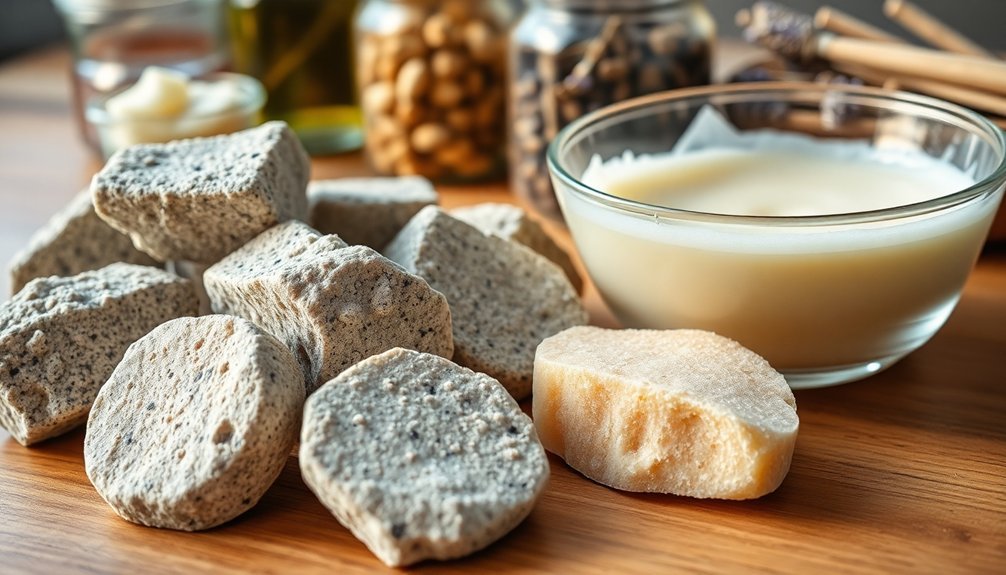
When creating homemade exfoliating soap, selecting the appropriate pumice type can make the difference between a harsh scrub and a gentle polish. You'll find pumice available in various textures, from finely powdered to coarsely ground varieties.
While you can collect natural pumice, be aware that harvesting from protected areas may be illegal. For smoother incorporation, consider grinding pumice finer using a mortar and pestle. This extra step guarantees even distribution throughout your soap.
Sustainable sourcing matters. Grind collected pumice thoroughly for a professional finish in your handcrafted soap.
If you prefer convenience, ground pumice is readily available from online suppliers. The amount you incorporate should be based on desired abrasiveness for your specific use case. The texture you choose directly impacts your soap's exfoliating properties.
Finer pumice creates a gentler polish, while coarser grades provide more aggressive exfoliation—perfect for removing tough calluses or for mechanics' hands.
Proper Dispersion Methods to Prevent Pumice Clumping
Achieving proper pumice dispersion throughout your soap requires careful technique to prevent frustrating clumps from forming.
Pre-mixing your pumice with a lightweight oil like olive or grapeseed creates a slurry that distributes more evenly when added to your soap batter.
For best results, follow these steps:
- Grind coarser pumice in a mortar and pestle to create a finer texture.
- Mix pumice with a small amount of your recipe oils before adding to batter.
- Add the pumice mixture gradually rather than all at once.
- Stir with a spatula first, then blend briefly with stick blender in short bursts.
A proper dispersion technique using approximately 5 tablespoons of pumice per batch creates an ideal level of exfoliation for rough skin areas like elbows and heels.
Remember to stop blending once the pumice is evenly distributed to maintain a pourable consistency for your soap batter.
Determining Optimal Pumice-to-Oil Ratios
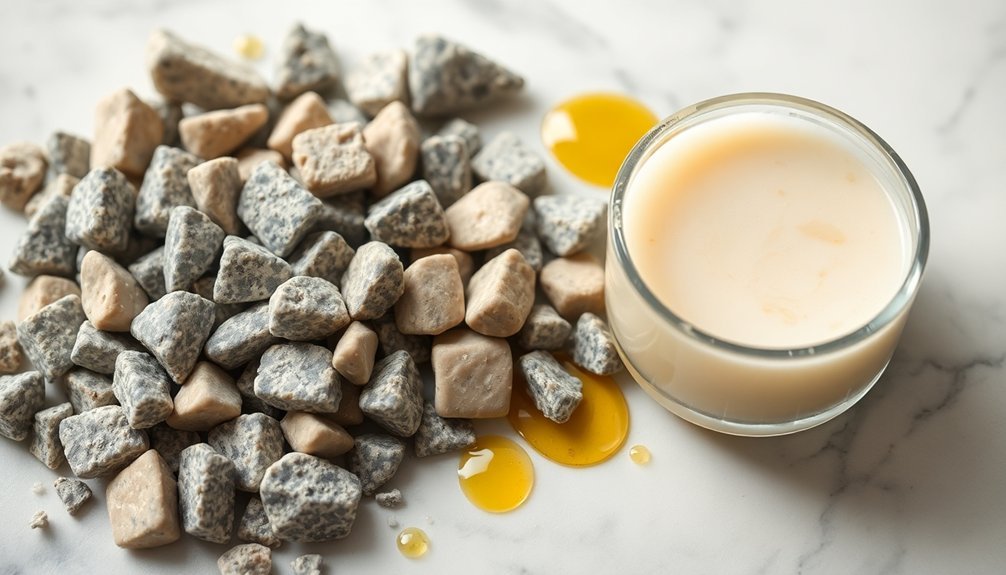
Finding the perfect balance of pumice in your homemade soap requires understanding key ratios that affect both scrubbing power and cleansing ability. A good starting point is 1 tablespoon per pound of oils, but you'll need to adjust based on your specific recipe.
Consider your oil blend carefully—tallow and lard create harder bars that may handle more pumice, while conditioning oils require careful balancing.
Too much pumice will create an overly abrasive bar with diminished cleansing properties.
Exercise caution with pumice amounts—excess creates harsh bars that sacrifice the cleansing action your soap needs to perform well.
Remember that skin type matters greatly. For sensitive areas, use less pumice; for gardener's or mechanic's soap, increase the ratio.
The recipe's typical ratio of 0.5 oz pumice to 20 oz total oils creates effective exfoliation without compromising soap quality.
Keep detailed notes during your test batches to identify your ideal formulation. The perfect ratio will provide effective exfoliation without sacrificing lather quality.
When to Add Pumice During the Soap Making Process
The timing of pumice addition marks an essential decision point in your soap-making journey. For best results, add pumice at mid-trace when your soap batter has reached a light to medium consistency. This prevents settling while allowing enough fluidity for thorough mixing.
To guarantee ideal distribution:
- Pre-mix your pumice with a small amount of your soap oils before adding to prevent clumping.
- Use brief bursts with your stick blender rather than continuous mixing, which can cause pumice to clump.
- Switch to a whisk for final mixing to distribute pumice evenly without over-thickening.
- Have your molds prepared in advance so you can pour immediately after mixing in the pumice.
Some crafters prefer adding pumice after the lye solution and before blending to achieve a light, workable trace that distributes the volcanic material consistently throughout the soap.
Combining Pumice With Complementary Natural Ingredients
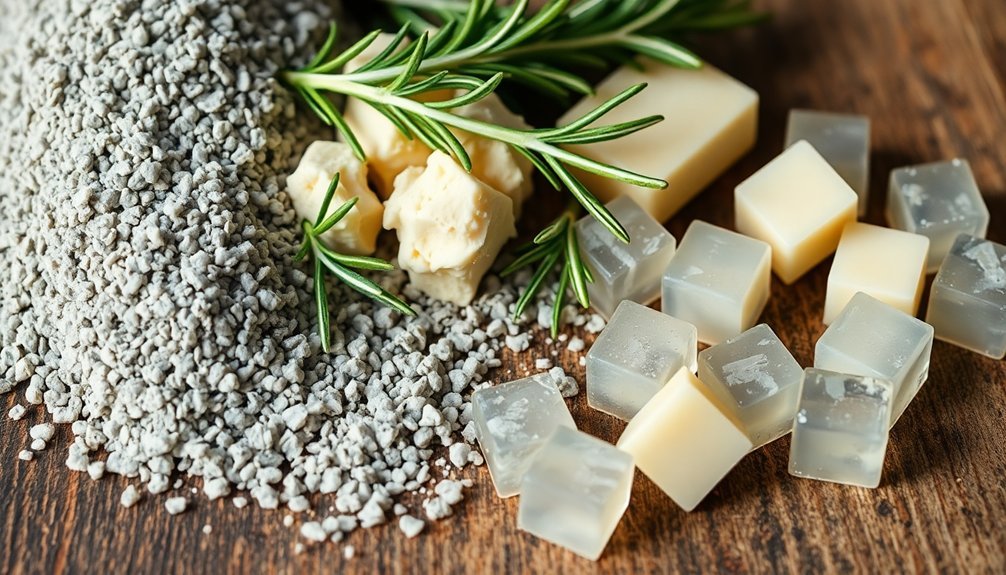
You'll find lavender and peppermint essential oils create invigorating aromatic synergies with pumice soap, enhancing both the sensory experience and skin benefits.
Adding calendula extract or petals offers soothing, anti-inflammatory properties that balance pumice's exfoliating action, making it gentler for sensitive skin.
These natural complements transform your pumice soap from a simple cleanser to a therapeutic skincare treatment with multiple benefits. Properly incorporated pumice powder tends to sink in melt and pour soap bases, requiring gentle stirring to maintain even distribution throughout your finished product.
Essential Oil Synergies
When creating pumice-infused soaps, essential oils offer more than just pleasant fragrances—they provide therapeutic benefits that complement the exfoliating properties of volcanic stone.
Aim for a 3% concentration by soap weight to achieve ideal aromatherapy benefits without overwhelming your creation.
Consider these powerful combinations for your pumice soap:
- Lavender & Lemongrass – Creates a balanced blend that soothes skin while counteracting pumice's roughness
- Peppermint & Eucalyptus – Delivers an invigorating experience perfect for mechanic's hands
- Tea Tree & Lavender – Offers purifying properties that work well with pumice's deep cleansing ability
- Cedarwood & Lemon – Extends shelf life while providing a fresh, grounding scent
Pre-mixing essential oils with your base oils before adding pumice helps distribute fragrance evenly and prevents acceleration issues. The synergistic effect of combining multiple essential oils creates powerful skin benefits that enhance the overall effectiveness of your pumice soap.
Calendula's Healing Touch
Beyond fragrant synergies, another botanical ally can elevate your pumice soap's benefits—calendula.
These golden petals pack powerful anti-inflammatory and antimicrobial properties that promote skin healing while complementing pumice's exfoliating action.
When incorporating calendula, use 1-2 tablespoons per batch for maximum benefits without overwhelming other ingredients. The recipe recommends using 1 tablespoon dried calendula flowers for the perfect balance in your exfoliating soap. The dried petals maintain their aesthetic appeal without significant color change in your soap.
You'll find they work excellently in both melt-and-pour and cold process methods.
For enhanced healing effects, consider pairing calendula with moisturizing ingredients like shea butter or castor oil, which contains anti-inflammatory properties that further aid skin repair.
This combination creates a balanced bar that exfoliates while soothing irritated skin.
You can also complement calendula with other florals like lavender or chamomile for distinctive therapeutic blends.
Adjusting Soap Formulas for Different Exfoliation Levels
Creating the perfect pumice soap requires careful formula adjustments to achieve your desired exfoliation level. The amount and texture of pumice you add directly impacts how abrasive your final soap will be. For sensitive skin, use fine-ground pumice in smaller quantities, while mechanics' soaps benefit from coarser grades. Pumice offers similar exfoliating benefits to oats, but with more scrubbing power for tougher cleaning jobs.
- Fine vs. Coarse – Fine-ground pumice provides gentle exfoliation suitable for facial soaps, while coarser varieties work better for removing stubborn grime from hands.
- Timing Matters – Add pumice at thin trace for even distribution throughout your soap.
- Balance Your Lather – Increase coconut oil content to maintain good lather when using pumice.
- Test First – Experiment with small batches to find your preferred exfoliation level before committing to larger productions.
Proper Curing and Storage of Pumice-Infused Soaps
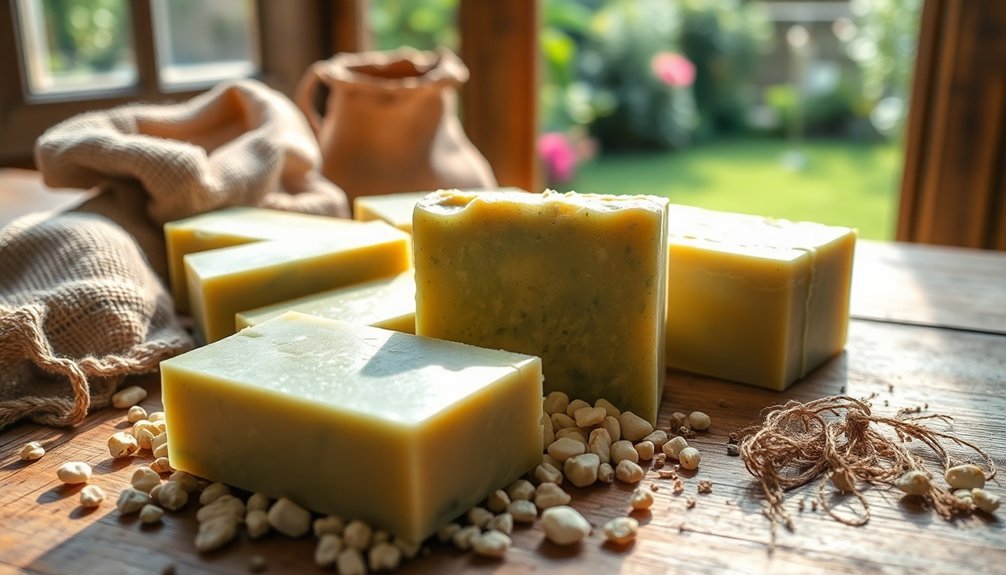
The success of your pumice soap depends greatly on proper curing techniques and storage methods.
Allow your bars to cure for 4-6 weeks in a well-ventilated area with consistent temperature and about 60% humidity. During this period, check periodically for cracks and always handle fresh soap with gloves to protect your skin.
Once cured, store your pumice soaps in a cool, dry environment away from direct sunlight.
Use breathable packaging that allows airflow to prevent moisture buildup which can compromise quality.
Keep storage areas clean and sanitized to prevent mold growth, and always store your soap away from chemicals or strong detergents to avoid contamination.
These simple practices will greatly extend the shelf life of your exfoliating bars.
For optimal exfoliation effects, consider experimenting with different amounts of ground pumice in your recipe, as this natural volcanic material creates effective scrubbing action.
Frequently Asked Questions
Can Pumice Soap Be Used on the Face?
No, you shouldn't use pumice soap on your face. It's too abrasive and can cause irritation, micro-abrasions, and skin damage. Consider gentler exfoliants like corn meal for facial care instead.
How Long Does Pumice Soap Typically Last Compared to Regular Soap?
Pumice soap typically doesn't last as long as regular soap due to its abrasive nature. You'll notice it wears down faster, especially with frequent use. Proper dry storage can help extend its lifespan.
Will Pumice Clog Drains Over Time?
Yes, pumice can clog your drains over time. The small particles accumulate in pipes, especially with regular use. You'll want to use pumice soap moderately and maintain your drains regularly to prevent buildups.
Can I Add Color to Pumice Soap Without Affecting Its Properties?
Yes, you can add color to pumice soap without affecting its exfoliating properties. Use skin-safe dyes or pigments, mixing them with oil first to guarantee even distribution and prevent clumping throughout your soap.
Is Pumice Soap Safe for Children to Use?
Pumice soap isn't ideal for children due to its abrasive nature. You'll want to use gentler alternatives for their sensitive skin. If they must use it, guarantee adult supervision and limit frequency to prevent irritation.
In Summary
You're now ready to create your perfect pumice soap! Remember, it's all about balance—too little won't exfoliate, too much will feel harsh. Start with small batches, adjust ratios as needed, and don't rush the curing process. With practice, you'll develop your signature pumice soap that offers just the right level of exfoliation while maintaining the nourishing properties you want.

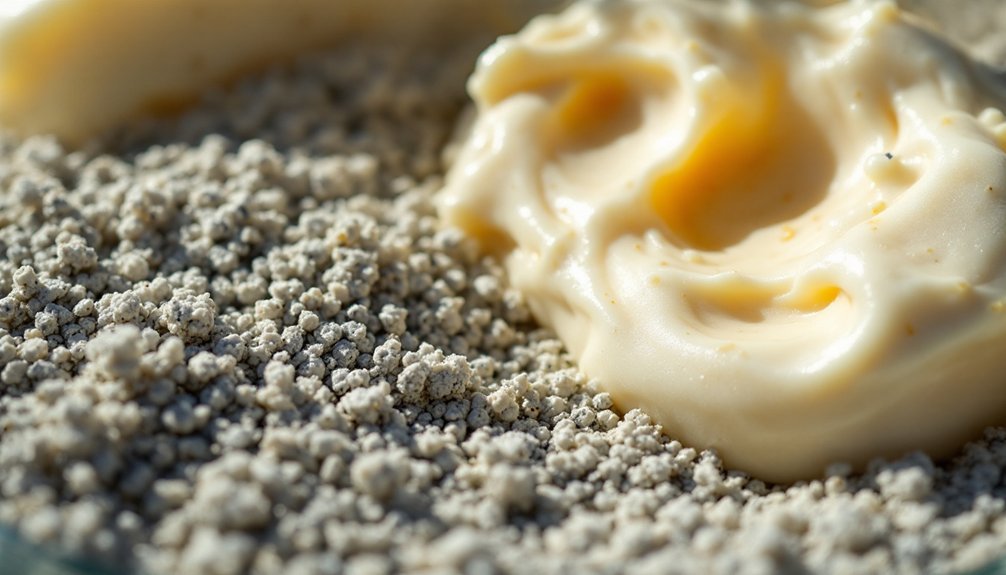



Leave a Reply